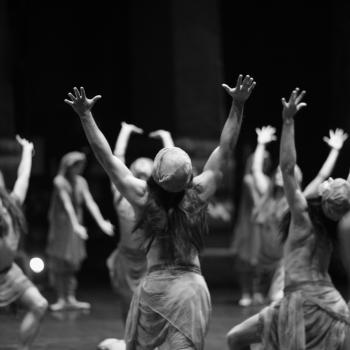 Back in September, I described a computer model my collaborator Rich Sosis and I built that simulates religious communities as complex adaptive systems. The model married complex-systems theory to human behavioral ecology, or the study of how human beings change their behavior according to different contexts and incentives — specifically, the evolutionary incentives of survival and reproduction. Applying this framework to human life leads to a striking conclusion: how loyal we are to our societies may hinge on whether those societies help us to stay healthy and to successfully find mates and have offspring. Neither of these goods alone will do the trick.
Back in September, I described a computer model my collaborator Rich Sosis and I built that simulates religious communities as complex adaptive systems. The model married complex-systems theory to human behavioral ecology, or the study of how human beings change their behavior according to different contexts and incentives — specifically, the evolutionary incentives of survival and reproduction. Applying this framework to human life leads to a striking conclusion: how loyal we are to our societies may hinge on whether those societies help us to stay healthy and to successfully find mates and have offspring. Neither of these goods alone will do the trick.
Reproduction is a big deal in evolution because it’s the only way for genetic material, the striving biological core of life, to persist through the centuries and millennia of change. Individual organisms die, but the genes that underlie them shoot endless copies of themselves into the next generation. The overarching biological purpose of life, then, is to ensure that next generation contains a generous helping of your own genes. Activities that ensure your survival — eating, staving off predators, finding shelter, avoiding expensive IRS audits, etc. — are all fine and good, but from a strictly evolutionary point of view they’re just means to an end. That end is fitness, defined in terms of the number of viable copies of yourself you leave behind after you shuffle off this moral coil helix.*
Since fitness, not survival, is the ultimate biological objective of the game of life, when a creature faces a trade-off between living longer and successfully reproducing, reproduction wins. This priority is reflected in the extraordinary sacrifices so many animals make to attract and win mates and, for some species (including humans), to care for and defend their young.
In extreme cases, animals sacrifice everything for their offspring. Most salmon species struggle against enormous odds to swim upstream to their ancestral spawning grounds, facing down hungry bears, razor-taloned eagles, roaring currents, and comically outfitted fishermen — only to die moments after spawning. Even more grotesquely, some spider mothers willingly let their own offspring consume them. Why? Again, evolution: spider babies that eat their mothers go on to be healthier, heavier, and more gregarious than those that don’t. It’s gruesome, but in biological terms, it’s a winning bet for the poor mother, because more copies of her genes will populate the next generation.
Ritual, Culture, and the Struggle for Survival Progeny
The model Rich and I built assumed that, from the scientific “view from nowhere,” human communities are large-scale collective action projects aimed at maximizing human fitness. This means that they exist in order to enhance individual survival and to facilitate successful reproduction. If they fail at these objectives, the loyalty and commitment of their members begins to wane. Disgruntled adherents begin consciously or subconsciously casting about for better options.
Practically speaking, this means that people gradually lose interest in the rituals, myths, and symbols of cultures that don’t perform well on biological metrics. This focus on ritual might seem counterintuitive. After all, the biological success of a community would seem to depend more on a successful economy, strong agricultural production, and excellent medical care than on impractical activities like praying or making sacrifices around an altar somewhere.
But a behavioral ecological perspective suggests that, in fact, ritual marks people’s emotional commitment and loyalty to the tribe far more clearly than practical activities like farming. When people partake in community rituals, they’re signaling to themselves and to others that they think the community’s normative expectations and requirements are legitimate. And when they see others participating alongside them, they intuit that their community norms enjoy substantial buy-in, making them even more confident in the community. It’s a self-reinforcing cycle.
But when the community stops functioning well, that virtuous ritual circle can invert, turning vicious. People who feel disaffected might stop joining in its rituals, or participate only half-heartedly. Others respond by becoming more tepid themselves. In a game-theoretic way, people only want to commit to communities that other people are also highly invested in. Otherwise, they risk low returns on their social expenditures. It’s a bit like choosing partners for a class project in high school — no one wants to be stuck with a group of free riders.
Our theory predicts, then, that people will be most enthusiastic about the rituals of communities that are biologically good bets.
High School as a General-Purpose Social System
For an informal test of this prediction, consider high school. The official function of schools is to impart learning, right? You’d think, then, that the students who are most loyal to their schools — the most misty-eyed about their ceremonies, pep rallies, letter jackets — would be those who are best at learning.
But that doesn’t seem to be true. I’m happy to hear corrections about this, but I don’t think it’s usually the most academically astute students who are the most “patriotic” for their schools, in terms of attending rallies, going to football games, proudly wearing letter jackets, and so on. Instead, it seems to be the students for whom high school is a relatively successful biological environment — one where they form strong, often lifelong friend networks that will help them survive and, yes, where they find attractive romantic partners.
In other words, there’s a case to be made that many students unconsciously treat their high schools as what Roy Rappaport called “general purpose” communities, not specialized ones aimed narrowly at learning.** General purpose communities include small-scale tribes, religious congregations, and nations. Their objective is simply to persist, which means maximizing the biological fitness of their individual members. Ergo, students tend to be most ritualistically loyal to high schools that offer biologically, er, fertile environments — not necessarily those that turn them into expert Latin grammarians.
Western, Educated, Industrialized, Rich, Democratic…and Single?
This theoretical framework has some sobering implications for liberal democracies such as the United States, which has both enjoyed a century of remarkable global power and wealth and, from at least some standpoints, is suddenly looking politically fragile. Why? Liberal democracies are heavily invested in the economic and material well-being of their citizens. They generally boast strong economies and expansive welfare safety nets. As a result, many Western countries and Japan (another quasi-liberal democracy) have achieved some of the highest life expectancies in the history of the world. Poverty, while not wiped out, is not the ubiquitous curse it once was in these lands.
But remember that there are two major biological objectives in life, survival and reproduction. Liberal democracies work hard to deliver the former, but the latter is less consistent a priority. The problem is that, from a sheer evolutionary perspective, the latter is the more important. Creatures that survive long into old age but never have offspring are not winners of the biological game.
If our model is at all accurate, human beings’ emotional investment in our communities and their rituals largely hangs on whether those communities deliver the full package of biological goods. When we see that our fellow tribe members are well-fed, wealthy, and long-lived, that’s great. But if our healthy, well-off compatriots seem to have trouble easily finding mates or starting families, we might subconsciously start losing faith in the tribe anyway.
America is an interesting test case of this prediction because the country’s birth rate is trending downwards while its death rate is rising. Current projections indicate that, by the middle of the 21st century, the two rates will be at parity. Marriage rates have consistently declined for the past generation, hitting the lowest level in history in 2018. At the same time, we seem to be experiencing a remarkable decline in emotional attachment to American symbols, myths, and national rituals, especially among the young. Participation in organized religion has collapsed, also particularly for younger people. Meanwhile, young people across the developed world have begun losing confidence in democracy.
It doesn’t immediately make sense, when you think about it, that inhabitants of superlatively wealthy, relatively politically stable countries would suddenly decide that their countries and their value systems aren’t worth believing in. But that is exactly what seems to be happening. If we take an evolutionary perspective, we at least have an hypothesis about why that is.
Societies are collective action projects, something like massively scaled-up teams. While a basketball team’s goal is to win games, the biological objective of a society or nation is to facilitate people’s survival and reproduction. Liberal political theory (liberal in the sense of “rooted in Enlightenment rationalism,” not in the sense of “left-wing”) sees the importance of the former of these two necessities, but its insight into the second is often somewhat dimmer. Yet facilitating successful reproduction may be even more important for keeping citizens loyal than protecting their health and retirement accounts.
Ritual and Unconscious Calculations
I’m not saying that people make conscious, deliberate decisions about these things. The history of the 20th century shows us clearly that, when given a choice between the convenience of childlessness and the hassles of children, many people opt for the former. Keep in mind that the decline of marriage rates is also probably partly due to gender-equal social norms that have weakened women’s economic dependence on men. Many people feel strongly supportive of these shifts, and if asked would vigorously affirm that it’s more important for women to be liberated from oppressive gender roles than it is for people to have big families.
But conscious calculations are precisely what ritual is not about. Evidence suggests that people’s gut-level decisions about whether to partake in cultural, national, or religious rituals have deep roots in biological imperatives, not conscious preferences. In English, this means that fitness, not convenience, informs how loyal we feel to our communities. Someone could be very much in favor of a highly individualistic national culture that encourages singleness, yet at the same time feel disaffected toward and disinvested in that same nation’s symbols precisely because its social environment doesn’t facilitate marriage and offspring — all without making that conscious connection.
This framework predicts that, all things being equal, communities should enjoy the most buy-in from members who enjoy good mechanisms for people to find mates, a strong likelihood of having offspring, and enough economic strength to support people through the life cycle. Offering oodles of wealth but poor prospects for biological fitness should correlate with less loyalty and buy-in — again, all things being equal.
These calculations may take place well beyond the conscious awareness of individual people, but they have very public consequences. If mass disaffection from and rejection of a society’s norms, symbols, and public rites is a threat to the viability of the society — as cultural evolution theory and game theory suggest it ought to be — then you could even make an argument that whether a country offers good fitness prospects is a matter of national security.
This, ladies and gentlemen, is why complex systems thinking and evolutionary approaches to human behavior belong together. The combination lets you go from matriphagous spiders to high school social dynamics to threats to national security in less time than it takes to hoist a flag — or tear one down.
________
* Technically, fitness is defined in relation to specific phenotypes (traits), not individuals. But you get the idea.
** Whereas students who dutifully treat their high schools as specialized social systems for learning, which is what they’re officially supposed to be, tend to race out the door to college and never look back.












